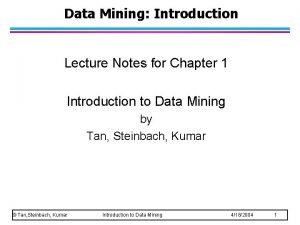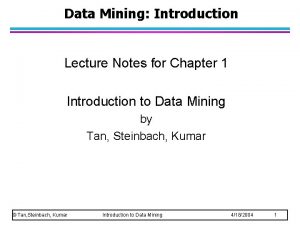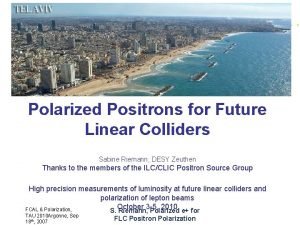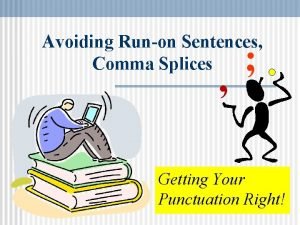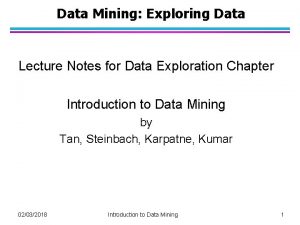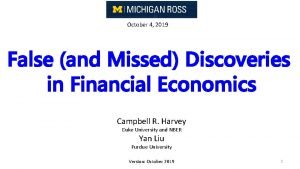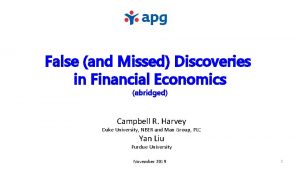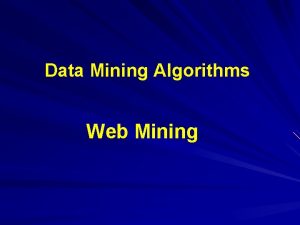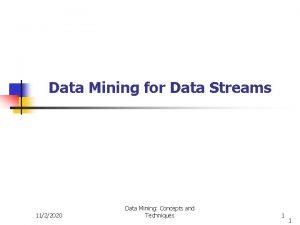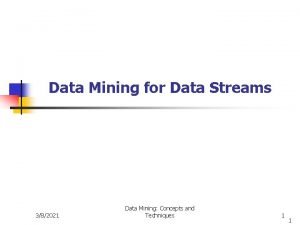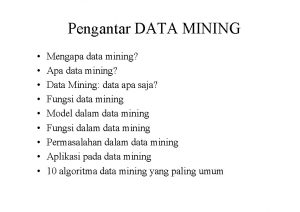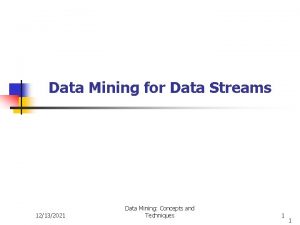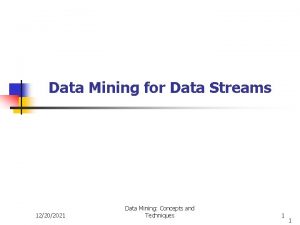Data Mining Avoiding False Discoveries Lecture Notes for


































- Slides: 34

Data Mining: Avoiding False Discoveries Lecture Notes for Chapter 10 Introduction to Data Mining, 2 nd Edition by Tan, Steinbach, Karpatne, Kumar 02/14/2018 Introduction to Data Mining, 2 nd Edition 1

Outline l Statistical Background l Significance Testing l Hypothesis Testing l Multiple Hypothesis Testing 02/14/2018 Introduction to Data Mining, 2 nd Edition 2

Motivation l An algorithm applied to a set of data will usually produce some result(s) – There have been claims that the results reported in more than 50% of published papers are false. (Ioannidis) l Results may be a result of random variation – Any particular data set is a finite sample from a larger population – Often significant variation among instances in a data set or heterogeneity in the population – Unusual events or coincidences do happen, especially when looking at lots of events – For this and other reasons, results may not replicate, i. e. , generalize to other samples of data l Results may not have domain significance – Finding a difference that makes no difference l Data scientists need to help ensure that results of data analysis are not false discoveries, i. e. , not meaningful or reproducible 02/14/2018 Introduction to Data Mining, 2 nd Edition 3

Statistical Testing l l Statistical approaches are used to help avoid many of these problems Statistics has well-developed procedures for evaluating the results of data analysis – Significance testing – Hypothesis testing l Domain knowledge, careful data collection and preprocessing, and proper methodology are also important – Bias and poor quality data – Fishing for good results – Reporting how analysis was done l Ultimate verification lies in the real world 02/14/2018 Introduction to Data Mining, 2 nd Edition 4

Probability and Distributions l Variables are characterized by a set of possible values – Called the domain of the variable – Examples: u True or False for binary variables u Subset of integers for variables that are counts, such as number of students in a class u Range of real numbers for variables such as weight or height A probability distribution function describes the relative frequency with which the values are observed l Call a variable with a distribution a random variable l 02/14/2018 Introduction to Data Mining, 2 nd Edition 5

Probability and Distributions. . l 02/14/2018 Introduction to Data Mining, 2 nd Edition 6

Binomial Distribution l 02/14/2018 k P(R= k) 0 1 2 3 4 5 6 7 8 9 10 0. 001 0. 044 0. 117 0. 205 0. 246 0. 205 0. 117 0. 044 0. 01 0. 001 Introduction to Data Mining, 2 nd Edition 7

Probability and Distributions. . l 02/14/2018 Introduction to Data Mining, 2 nd Edition 8

Gaussian Distribution l 02/14/2018 Introduction to Data Mining, 2 nd Edition 9

Statistical Testing l 02/14/2018 Introduction to Data Mining, 2 nd Edition 10

Examples of Null Hypotheses l A coin or a die is a fair coin or die. l The difference between the means of two samples is 0 l The purchase of a particular item in a store is unrelated to the purchase of a second item, e. g. , the purchase of bread and milk are unconnected l The accuracy of a classifier is no better than random 02/14/2018 Introduction to Data Mining, 2 nd Edition 11

Significance Testing – Significance testing was devised by the statistician Fisher – Only interested in whether null hypothesis is true – Significance testing was intended only for exploratory analyses of the null hypothesis in the preliminary stages of a study u For example, to refine the null hypothesis or modify future experiments – For many years, significance testing has been a key approach for justifying the validity of scientific results – Introduced the concept of p-value, which is widely used and misused 02/14/2018 Introduction to Data Mining, 2 nd Edition 12

How Significance Testing Works l 02/14/2018 Introduction to Data Mining, 2 nd Edition 13

How Significance Testing Works … l 02/14/2018 Introduction to Data Mining, 2 nd Edition 14

Example: Testing a coin for fairness l 02/14/2018 Introduction to Data Mining, 2 nd Edition k P(S = k) 0 1 2 3 4 5 6 7 8 9 10 0. 001 0. 044 0. 117 0. 205 0. 246 0. 205 0. 117 0. 044 0. 01 0. 001 15

One-sided and Two-sided Tests l 02/14/2018 Introduction to Data Mining, 2 nd Edition 16

One-sided and Two-sided Tests … l 02/14/2018 Introduction to Data Mining, 2 nd Edition 17

Neyman-Pearson Hypothesis Testing l 02/14/2018 Introduction to Data Mining, 2 nd Edition 18

Hypothesis Testing … l 02/14/2018 Introduction to Data Mining, 2 nd Edition 19

Hypothesis Testing … l Power: which is the probability of the critical region under H 1, i. e. , 1−β. – Power indicates how effective a test will be at correctly rejecting the null hypothesis. – Low power means that many results that actually show the desired pattern or phenomenon will not be considered significant and thus will be missed. – Thus, if the power of a test is low, then it may not be appropriate to ignore results that fall outside the critical region. 02/14/2018 Introduction to Data Mining, 2 nd Edition 20

Example: Classifying Medical Results l 02/14/2018 Introduction to Data Mining, 2 nd Edition 21

02/14/2018 Introduction to Data Mining, 2 nd Edition 22

Hypothesis Testing: Effect Size l Many times we can find a result that is statistically significant but not significant from a domain point of view – A drug that lowers blood pressure by one percent l Effect size measures the magnitude of the effect or characteristic being evaluated, and is often the magnitude of the test statistic. – Brings in domain considerations l The desired effect size impacts the choice of the critical region, and thus the significance level and power of the test 02/14/2018 Introduction to Data Mining, 2 nd Edition 23

Effect Size: Example Problem l Consider several new treatments for a rare disease that have a particular probability of success. If we only have a sample size of 10 patients, what effect size will be needed to clearly distinguish a new treatment from the baseline which has is 60 % effective? R/p(X=1) 0 1 2 3 4 5 6 7 8 9 10 02/14/2018 0. 60 0. 0001 0. 0016 0. 0106 0. 0425 0. 1115 0. 2007 0. 2508 0. 2150 0. 1209 0. 0403 0. 0060 0. 70 0. 0001 0. 0014 0. 0090 0. 0368 0. 1029 0. 2001 0. 2668 0. 2335 0. 1211 0. 0282 0. 80 0. 0000 0. 0001 0. 0008 0. 0055 0. 0264 0. 0881 0. 2013 0. 3020 0. 2684 0. 1074 0. 90 0. 0000 0. 0001 0. 0015 0. 0112 0. 0574 0. 1937 0. 3874 0. 3487 Introduction to Data Mining, 2 nd Edition 24

Multiple Hypothesis Testing l 02/14/2018 Introduction to Data Mining, 2 nd Edition 25

Summarizing the Results of Multiple Tests l The following confusion table defines how results of multiple tests are summarized – We assume the results fall into two classes, + and –, which, follow the alternative and null hypotheses, respectively. – The focus is typically on the number of false positives (FP), i. e. , the results that belong to the null distribution (– class) but are declared significant (+ class). 02/14/2018 Introduction to Data Mining, 2 nd Edition 26

Family-wise Error Rate l 02/14/2018 Introduction to Data Mining, 2 nd Edition 27

Bonferroni Procedure l 02/14/2018 Introduction to Data Mining, 2 nd Edition 28

Example: Bonferroni versus Naïve approach l Naïve approach is to evaluate statistical significance for each result without adjusting the significance level. 02/14/2018 Introduction to Data Mining, 2 nd Edition 29

False Discovery Rate l 02/14/2018 Introduction to Data Mining, 2 nd Edition 30

Benjamini-Hochberg Procedure l 02/14/2018 Introduction to Data Mining, 2 nd Edition 31

FDR Example: Picking a stockbroker l 02/14/2018 Introduction to Data Mining, 2 nd Edition 32

FDR Example: Picking a stockbroker … l The following figure compares the naïve approach, Bonferroni, and the BH FDR procedure with respect to the power for various numbers of tests, m. 1/3 of the sample were from the alternative distribution. 02/14/2018 Introduction to Data Mining, 2 nd Edition 33

Comparison of FWER and FDR l FWER is appropriate when it is important to avoid any error. – But an FWER procedure such as Bonferroni makes many Type II errors and thus, has poor power. – An FWER approach has very a very false discovery rate l FDR is appropriate when it is important to identity positive results, i. e. , those belonging to the alternative distribution. – By construction, the false discovery rate is good for an FDR procedure such as the BH approach – An FDR approach also has good power 02/14/2018 Introduction to Data Mining, 2 nd Edition 34
 Methods to avoid false discoveries in data mining
Methods to avoid false discoveries in data mining Bayesian classification in data mining lecture notes
Bayesian classification in data mining lecture notes Data mining lecture notes
Data mining lecture notes Data mining lecture notes
Data mining lecture notes Data mining lecture notes
Data mining lecture notes Mining complex types of data in data mining
Mining complex types of data in data mining 01:640:244 lecture notes - lecture 15: plat, idah, farad
01:640:244 lecture notes - lecture 15: plat, idah, farad How to avoid foolish opinion
How to avoid foolish opinion Mining multimedia databases in data mining
Mining multimedia databases in data mining Exploratory data analysis lecture notes
Exploratory data analysis lecture notes 102 dr
102 dr False and false
False and false Sabine riemann
Sabine riemann Galileo galilei discoveries
Galileo galilei discoveries James prescott joule inventions
James prescott joule inventions Strip mining vs open pit mining
Strip mining vs open pit mining Mineral resources and mining chapter 13
Mineral resources and mining chapter 13 Difference between strip mining and open pit mining
Difference between strip mining and open pit mining Difference between text mining and web mining
Difference between text mining and web mining On formalizing fairness in prediction with machine learning
On formalizing fairness in prediction with machine learning Accommodating teddy bear
Accommodating teddy bear Run on sentences game
Run on sentences game Avoiding insider trading training
Avoiding insider trading training Avoiding fragments and run-ons
Avoiding fragments and run-ons Types of body
Types of body Chapter 12 lesson 2 improving your fitness
Chapter 12 lesson 2 improving your fitness Teddy bear conflict management style
Teddy bear conflict management style Avoiding run on sentences
Avoiding run on sentences Techniques for avoiding resource overload? *
Techniques for avoiding resource overload? * Evans v triplex safety glass
Evans v triplex safety glass Avoiding type adler
Avoiding type adler What's the best strategy for avoiding atm fees?
What's the best strategy for avoiding atm fees? Complete the introduction giving advice on avoiding
Complete the introduction giving advice on avoiding Uts library referencing
Uts library referencing Avoiding the sun
Avoiding the sun



